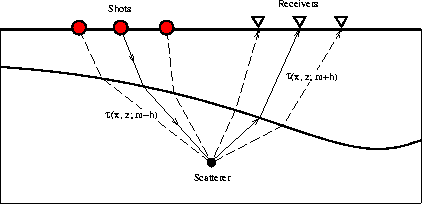




Next: EFFICIENT COMPUTATIONS OF IMAGE
Up: GENERALIZED IMAGE-RAY METHOD
Previous: Profile imaging
Because a constant offset section is an offset continuation of a
zero offset section, I assume that the diffraction curve
on a constant offset section is well approximated by a flat top
hyperbola in the vicinity of its apex when the lateral velocity variations
are confined to a reasonable scale.
Consequently, a constant offset time-migration
can collapse the energy distributed over this portion of the diffraction curve.
For a given time image position (t0,x0), the migration curve of
the constant-offset Kirchhoff summation is:
|  |
(7) |
where vm is a migration velocity, m and h are midpoint and half offset,
respectively.
For a given half offset h, this equation defines traveltime t
as a function of midpoint m.
The coordinates of the apex of the migration curve are:
|  |
(8) |
Thus, the Kirchhoff time-migration focuses the diffracted energy
along the diffraction curve whose apex is at (ta,ma) to the point
(t0,x0) of the time-migrated image.
The correct time-to-depth conversion should map the image sample at
(t0,x0) to the true position (x,z) of the scatterer.
Similarly to profile imaging, I define
image rays for constant offset imaging to be the propagation paths of
the energy in the signals at the apex positions of diffraction curves
on a constant offset section. At the apex of the diffraction curve,
the derivative of the traveltime with respective to
the midpoint location is zero. We know that the traveltime is
 . If we define p(x,z;xs) to be
the partial derivative of
. If we define p(x,z;xs) to be
the partial derivative of  with respect to xs,
then image rays for constant offset imaging satisfy the following relation:
with respect to xs,
then image rays for constant offset imaging satisfy the following relation:
|
p(x,z;m-h)+p(x,z;m+h)=0.
|
(9) |
Figure ![[*]](http://sepwww.stanford.edu/latex2html/cross_ref_motif.gif) shows an example of such an image ray.
By tracing the image ray passing through the scatterer at
subsurface position (x,z),
we can find the coordinates of the apex position of the diffraction curve,
as follows:
shows an example of such an image ray.
By tracing the image ray passing through the scatterer at
subsurface position (x,z),
we can find the coordinates of the apex position of the diffraction curve,
as follows:
|  |
(10) |
Combining equations (10) and (7) gives
us the mapping functions of time-to-depth conversion, as follows:
|  |
(11) |
Because these two mapping functions contain an implicit function, the image-ray
corrections for constant offset imaging is more difficult than one
for profile imaging.
imraycos
Figure 2 Ray paths in a constant offset experiment. The solid line shows an image ray.






Next: EFFICIENT COMPUTATIONS OF IMAGE
Up: GENERALIZED IMAGE-RAY METHOD
Previous: Profile imaging
Stanford Exploration Project
11/18/1997

![]() . If we define p(x,z;xs) to be
the partial derivative of
. If we define p(x,z;xs) to be
the partial derivative of ![]() with respect to xs,
then image rays for constant offset imaging satisfy the following relation:
with respect to xs,
then image rays for constant offset imaging satisfy the following relation:
![[*]](http://sepwww.stanford.edu/latex2html/cross_ref_motif.gif) shows an example of such an image ray.
By tracing the image ray passing through the scatterer at
subsurface position (x,z),
we can find the coordinates of the apex position of the diffraction curve,
as follows:
shows an example of such an image ray.
By tracing the image ray passing through the scatterer at
subsurface position (x,z),
we can find the coordinates of the apex position of the diffraction curve,
as follows:


